
Joan de Beauvoir de Havilland, known professionally as Joan Fontaine, was an English-American actress who is best known for her starring roles in Hollywood films during the Golden Age of Hollywood. Fontaine appeared in more than 45 films in a career that spanned five decades. She was the younger sister of actress Olivia de Havilland. Their rivalry was well-documented in the media at the height of Fontaine's career.

Body and Soul (1931) is an American Pre-Code action drama film directed by Alfred Santell and starring Charles Farrell, Elissa Landi, Humphrey Bogart, and Myrna Loy. The story, adapted from the stage play Squadrons by Elliott White Springs and A.E. Thomas, depicts Royal Air Force pilots in World War I.
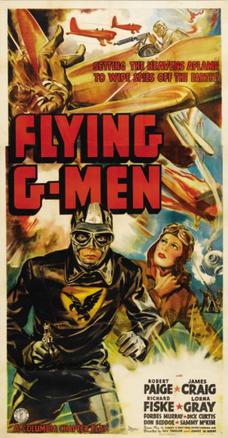
Flying G-Men is a 15-episode 1939 adventure film Film serial, directed by James W. Horne and Ray Taylor. The serial was the sixth of the 57 serials released by Columbia. Four "Flying G-Men" battle with enemy saboteurs intent on destroying American military defences.
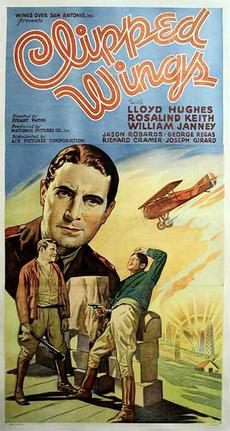
Clipped Wings is a 1937 American crime and aviation Kier-Phillips production for National pictures, directed by Stuart Paton from an original story and screenplay by Paul Willett. The film stars Lloyd E. Hughes, Rosalind Keith and William Janney.
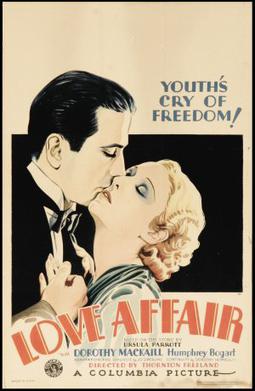
Love Affair is a 1932 American pre-Code romance film based on Ursula Parrott's short story of the same name. The film is directed by Thornton Freeland and produced by Columbia Pictures. Love Affair follows an adventurous socialite, who is in love with an aviation designer.

The Lost Squadron is a 1932 American pre-Code drama, action, film starring Richard Dix, Mary Astor, and Robert Armstrong, with Erich von Stroheim and Joel McCrea in supporting roles, and released by RKO Radio Pictures. Based on the novel The Lost Squadron (1932) by Dick Grace, the film is about three World War I pilots who find jobs after the war as Hollywood stunt fliers.

Murder in the Clouds is a 1934 American action film dealing with aviation. The film stars Lyle Talbot and Ann Dvorak, and is directed by D. Ross Lederman. Although standard formula "B" film fare, it was notable as the screenplay and original story was written by Dore Schary as a freelance writer, during one of his periods when he was fired from a more prestigious film job. Schary was a director, writer, producer and playwright who later became head of production at Metro-Goldwyn-Mayer, and eventually president of the studio. Equally important on Murder in the Clouds was the work of Elmer Dyer who had become a preeminent aviation cinematographer.

High Flyers is a 1937 American musical comedy film directed by Edward Cline and starring the comedy team of Wheeler & Woolsey in their final film together. Robert Woolsey died less than a year after the film was released. The supporting cast includes Lupe Vélez, Margaret Dumont, Marjorie Lord, Paul Harvey and Jack Carson. The film was produced and distributed by RKO Pictures.
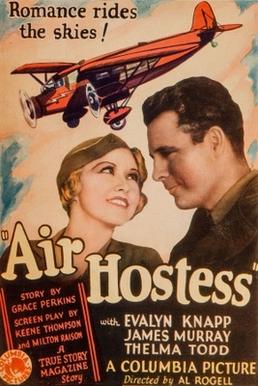
Air Hostess is a 1933 American Pre-Code aviation-themed melodrama based on a serial published in a 1919 True Story Magazine article called Air Hostess by Grace Perkins, also known as Dora Macy. Director Albert Rogell who had moved from shorts to B-films, had been interested in aviation having already helmed a similar feature, The Flying Marine (1929). In Air Hostess, the studio had attempted to merge flying and romance. Advertising stressed, "A date in the skies ... a rendezvous in the heavens...where love zooms with thrill after thrill ... but finds a happy landing!"

Ace of Aces, also known as Bird of Prey, is a 1933 American pre-Code war film based on the story "The Bird of Prey" by World War I pilot John Monk Saunders that explores how war can turn a man's moral compass from pacifism to warmonger. Starring Richard Dix, it was similar to many of the period films that appeared to glorify the "knights of the air", but was more complex, examining the motivations of those who choose to go to war.
The Sky Hawk is a 1929 American pre-Code adventure film, produced and distributed by Fox Film Corporation and directed by John G. Blystone. The screenplay was adapted by Llewellyn Hughes from his article "Chap Called Bardell" and novelized by Guy Fowler. The film stars John Garrick, Helen Chandler and Gilbert Emery.

Flying Devils is a 1933 American Pre-Code action film dealing with aviation. The film was directed by former Hollywood agent Russell Birdwell and photographed by film noir cinematographer Nicholas Musuraca. The screenplay was written by Byron Morgan and Louis Stevens, based on an original story by Stevens. In an unusual move, Bruce Cabot was the star, with perennial "good guy" Ralph Bellamy playing the villain in a love triangle involving Arline Judge and Eric Linden. Although considered a "B" feature, audiences enjoyed the aerial scenes, which helped elevate the feature to a minor box-office hit.
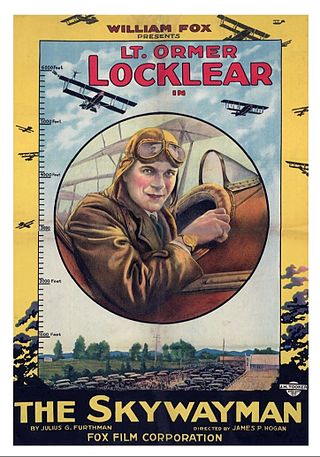
The Skywayman is a 1920 American silent action drama film directed by James P. Hogan and produced and distributed by Fox Film Corporation. The film starred noted aerial stunt pilot Ormer Locklear and Louise Lovely. After having appeared in The Great Air Robbery (1919), a film that showcased his aerial talents, Locklear, considered the foremost "aviation stunt man in the world", was reluctant to return to the air show circuit. During the production, Locklear and his co-pilot Milton "Skeets" Elliot died after crashing during a night scene. The Skywayman was subsequently released shortly after, capitalizing on their deaths.

The Marines Fly High is a 1940 action film, starring Richard Dix, Chester Morris and Lucille Ball and directed by George Nicholls, Jr. and Benjamin Stoloff from a story by A.C. Edington.

Daredevils of the Clouds is a 1948 American drama film directed by George Blair and produced by Republic Pictures. The film stars Robert Livingston, Mae Clarke and James Cardwell. Daredevils of the Clouds depicts bush pilot flying in northern Canada.

20,000 Men a Year is a 1939 American action film directed by Alfred E. Green and written by Lou Breslow and Owen Francis. The film stars Randolph Scott, Preston Foster, Margaret Lindsay, Mary Healy, Robert Shaw, George Ernest, Jane Darwell, Kane Richmond and Maxie Rosenbloom. It was the fourth and last film produced by Cosmopolitan Pictures in its final year of operation.

Pirates of the Sky is a 1926 American silent adventure melodrama film directed by Charles Andrews. The film stars Charles Hutchison, Wanda Hawley and Crauford Kent. In different sources, Pirates of the Sky distributed by Pathé Exchange has conflicting release dates of February 20, 1926 and March 21, 1927.

John Trent was an aviator-turned-actor-turned-aviator, best known as an actor for the "Tailspin Tommy" adventure film series in the 1930s. From 1931 to 1941, under the stage name John Trent, Browne appeared in 16 Hollywood films. While flying was a natural for him, acting was not, and he eventually turned his back on his Hollywood career, resuming his career in aviation, as a test pilot.

The Sky Spider is a 1931 American "youth-oriented" adventure film. Directed by Richard Thorpe, the film starred Glenn Tryon, Beryl Mercer, Blanche Mehaffey, Pat O'Malley and newcomer John Trent.

Alice Bertha Curtis was an American suffragist active with the National American Woman's Suffrage Association, a college professor, author of two fictionalized childhood memoirs, Children of the Prairie (1938) and Winter on the Prairie (1945), and the writer of the short story "Wings of Mercy" that was adapted for the 1937 RKO movie The Man Who Found Himself.




















